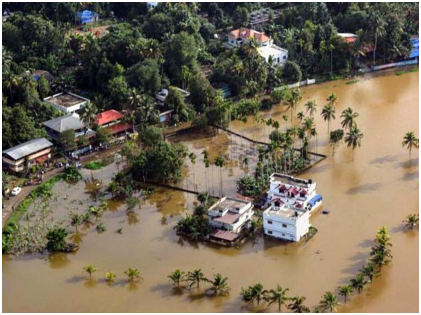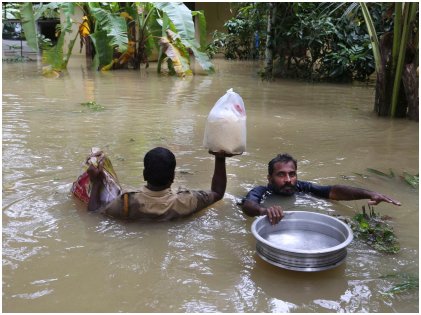Torrential rains have caused unprecedented floods in the Indian state of Kerala, claiming more than 350 lives and rendering thousands of others homeless. Local officials and news agencies claim that the 2018 Kerala floods is the worst flooding situation in last 100 years or so. India’s monsoon season usually starts in June, but the south-western state received heavy rainfall since August 8 this year, resulting in the local dams filling to their capacity. As of now, rescue operations are in full swing as various local, national, and international disaster management teams are battling the heavy torrential downpour to reach out to more than two hundred thousand people stuck in camps and elsewhere.
Children And Old People Are Among The Worst-Affected
 The government of the state said that many of those killed actually got crushed under the huge debris caused by massive landslides. More rains are predicted by the country’s meteorological authorities, and a state-wide red alert is already in place. The situation is so grave that the busiest airport in the state, Cochin International Airport, will remain closed until August 26, according to the government announcement in the wake of the events. Hundreds of paramilitary troops are working double time to rescue hundreds of helpless civilians caught up in the most unusual of places. Photographs and various footage captured from helicopters show that children and elderly people are among those who are badly hit by the monsoon floods.
The government of the state said that many of those killed actually got crushed under the huge debris caused by massive landslides. More rains are predicted by the country’s meteorological authorities, and a state-wide red alert is already in place. The situation is so grave that the busiest airport in the state, Cochin International Airport, will remain closed until August 26, according to the government announcement in the wake of the events. Hundreds of paramilitary troops are working double time to rescue hundreds of helpless civilians caught up in the most unusual of places. Photographs and various footage captured from helicopters show that children and elderly people are among those who are badly hit by the monsoon floods.
Schools Closed, Business Disrupted, Tourism Sector Devastated
 Pinarayi Vijayan, the chief minister of the state, has described the 2018 Kerala floods as the worst in the state’s last 100 years of history. He told the press that 223,000 people are now stranded in more than one thousand and five hundred emergency relief and rescue camps set up across the state. Much like its airport, the commercial capital of the state, Cochin, is pretty much underwater, and inaccessible for the most part. Local plantations are also inundated by water, posing a major threat to the otherwise thriving local tea, rubber, coffee, as well as spice industries. Schools across all fourteen states have been shut down for an indefinite period, and tourists are not allowed to enter certain regions, including Munnar, one of the most popular hill stations in the state.
Pinarayi Vijayan, the chief minister of the state, has described the 2018 Kerala floods as the worst in the state’s last 100 years of history. He told the press that 223,000 people are now stranded in more than one thousand and five hundred emergency relief and rescue camps set up across the state. Much like its airport, the commercial capital of the state, Cochin, is pretty much underwater, and inaccessible for the most part. Local plantations are also inundated by water, posing a major threat to the otherwise thriving local tea, rubber, coffee, as well as spice industries. Schools across all fourteen states have been shut down for an indefinite period, and tourists are not allowed to enter certain regions, including Munnar, one of the most popular hill stations in the state.
A Man-Made Disaster?
 Prime Minister Narendra Modi arrived in the state a couple of days back, and he is yet to visit the most horribly affected areas. The state government has also started a fundraising drive, and both non-resident Indians and public figures have come forward to generously donate essential supplies and funds to help the government and its agencies to carry on the rescue operations. While active monsoon is believed to be the primary cause behind the floods, environmentalists have also blamed rapid deforestation and the government’s failure to protect the fragile mountain ranges. Mr. Vijayan, however, has put the blame partially on Tamil Nadu, a neighboring Indian state, for the worsening of the situation.
Prime Minister Narendra Modi arrived in the state a couple of days back, and he is yet to visit the most horribly affected areas. The state government has also started a fundraising drive, and both non-resident Indians and public figures have come forward to generously donate essential supplies and funds to help the government and its agencies to carry on the rescue operations. While active monsoon is believed to be the primary cause behind the floods, environmentalists have also blamed rapid deforestation and the government’s failure to protect the fragile mountain ranges. Mr. Vijayan, however, has put the blame partially on Tamil Nadu, a neighboring Indian state, for the worsening of the situation.
Tragedy Looms Large
 There are forty-one rivers flowing through Kerala, and 80 dams have been opened after the water level rose to overflow level. A majority of the water treatment plants in the state are now submerged, and most of the motors are irreversibly damaged, the chief minister was quoted saying. There is a high possibility that the death toll will rapidly escalate once the water levels recede. Krishna Jayan, a 58-year-old local resident, told BBC that she was at her home, sleeping, when a friend wakened her. She opened the door and water surged in. By the time she was out on the streets, she was neck deep in water. Locals helped each other walk through the flood waterm and they got a bus to escape. Shabbir Saheel, a 33-year-old, carried his two-year-old daughter on his shoulders to reach a safe zone. Thousands of people are still marooned, desperately looking for food, water, and medicine.
There are forty-one rivers flowing through Kerala, and 80 dams have been opened after the water level rose to overflow level. A majority of the water treatment plants in the state are now submerged, and most of the motors are irreversibly damaged, the chief minister was quoted saying. There is a high possibility that the death toll will rapidly escalate once the water levels recede. Krishna Jayan, a 58-year-old local resident, told BBC that she was at her home, sleeping, when a friend wakened her. She opened the door and water surged in. By the time she was out on the streets, she was neck deep in water. Locals helped each other walk through the flood waterm and they got a bus to escape. Shabbir Saheel, a 33-year-old, carried his two-year-old daughter on his shoulders to reach a safe zone. Thousands of people are still marooned, desperately looking for food, water, and medicine.
The Situation Now
As per the latest reports, the situation is easing up in most parts of the region, with heavy rainfall predicted only in a few districts of the state. As the water recedes, air-borne and water-borne diseases are likely to break out in parts of the state. Health and sanitation is the priority of the state government now, and more than 15,000 people have already been moved to safer places. However, more than six hundred thousand people are still stranded in relief camps, and rehabilitation of these people remains a major task ahead for the authorities.





